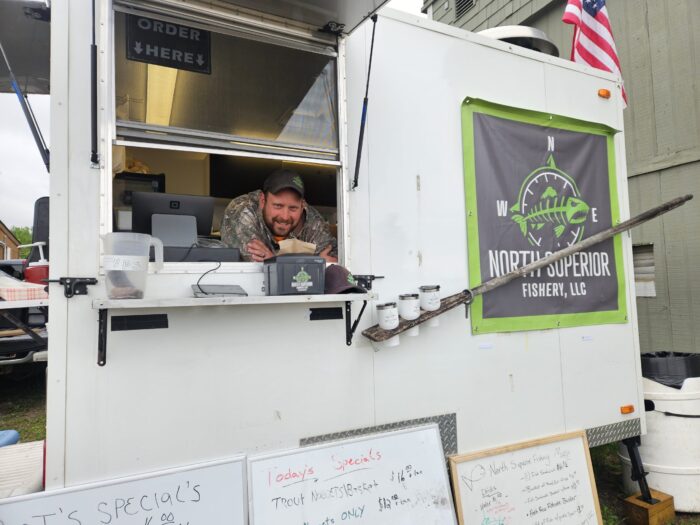Local Business Spotlight: North Superior Fishery – WTIP

North Superior Fishery Celebrates One Year of Sustainable Business Expansion
Introduction
This month marks the one-year anniversary of North Superior Fishery’s launch of its food truck in Grand Marais, a milestone that highlights the company’s commitment to sustainable economic growth and community engagement aligned with the Sustainable Development Goals (SDGs).
Business Operations and Community Impact
Owners Eric Brisson and Tyler Smith have successfully balanced the multifaceted demands of commercial fishing, food truck operations, and marketing management. The food truck operates Tuesday through Saturday from 11 a.m. to 6 p.m., located strategically between Java Moose and Harbor Inn, contributing to local economic development (SDG 8: Decent Work and Economic Growth).
- Food truck offerings include fish sandwiches, trout nuggets, and fish cakes, utilizing freshly caught fish.
- Operations are flexible, closing early if the daily fish supply is sold out, ensuring resource efficiency (SDG 12: Responsible Consumption and Production).
Supply Chain and Distribution Network
North Superior Fishery supports local food systems by supplying fresh fish to numerous grocery stores and restaurants along the North Shore, fostering sustainable consumption patterns and local economic resilience (SDG 2: Zero Hunger; SDG 11: Sustainable Cities and Communities).
- Local outlets include Johnson’s Foods, IGA, My Sister’s Place, Cook County Co-op, Poplar Haus, Fisherman’s Daughter, Angry Trout Cafe, and Bluefin Grille in Tofte.
- Expanded distribution reaches Super One Foods in Two Harbors and Zups in Silver Bay.
- Recent initiatives include shipping fish to Minneapolis and St. Paul, broadening market access and promoting sustainable fisheries (SDG 14: Life Below Water).
Community Engagement and Promotion
In collaboration with WTIP and local organizations such as Visit Cook County and the Cook County Chamber of Commerce, North Superior Fishery has been featured in the Local Business Spotlight. This initiative promotes local business innovation and economic strength, reinforcing partnerships that support sustainable community development (SDG 17: Partnerships for the Goals).
Conclusion
North Superior Fishery’s integrated approach to sustainable fishing, local food service, and community collaboration exemplifies a model aligned with multiple Sustainable Development Goals, contributing to economic growth, responsible resource management, and strengthened local partnerships.
1. Sustainable Development Goals (SDGs) Addressed or Connected
- SDG 2: Zero Hunger – The article discusses the supply of fresh fish to local communities, grocery stores, and restaurants, contributing to food availability and nutrition.
- SDG 8: Decent Work and Economic Growth – The business operations of North Superior Fishery, including commercial fishing, food truck management, and local economic engagement, relate to promoting sustained economic growth and productive employment.
- SDG 12: Responsible Consumption and Production – The focus on local sourcing and distribution of fish suggests sustainable production and consumption practices.
- SDG 14: Life Below Water – As a commercial fishing enterprise, the article implicitly connects to sustainable management of marine resources.
2. Specific Targets Under the Identified SDGs
- SDG 2 – Target 2.1: By 2030, end hunger and ensure access by all people to safe, nutritious, and sufficient food all year round. The article highlights the availability of fresh fish products to local communities and beyond.
- SDG 8 – Target 8.3: Promote development-oriented policies that support productive activities, decent job creation, entrepreneurship, and innovation. The article emphasizes entrepreneurship and business innovation through the food truck and expanded market reach.
- SDG 12 – Target 12.2: Achieve sustainable management and efficient use of natural resources. The article’s focus on local fishing and distribution implies sustainable resource use.
- SDG 14 – Target 14.4: Effectively regulate harvesting and end overfishing to restore fish stocks. While not explicitly stated, the commercial fishing practices relate to this target.
3. Indicators Mentioned or Implied to Measure Progress
- Indicator for SDG 2.1: Proportion of population with access to safe, nutritious, and sufficient food. Implied by the availability of fresh fish in local markets and food trucks.
- Indicator for SDG 8.3: Proportion of informal employment in non-agriculture sectors and number of new businesses created. Implied by the establishment and operation of the food truck and expanded business activities.
- Indicator for SDG 12.2: Material footprint, material footprint per capita, and domestic material consumption. Implied through sustainable sourcing and local distribution practices.
- Indicator for SDG 14.4: Proportion of fish stocks within biologically sustainable levels. Implied through the commercial fishing activities and the need to balance supply and demand.
4. Table: SDGs, Targets and Indicators
| SDGs | Targets | Indicators |
|---|---|---|
| SDG 2: Zero Hunger | Target 2.1: End hunger and ensure access to safe, nutritious, and sufficient food all year round. | Proportion of population with access to safe, nutritious, and sufficient food. |
| SDG 8: Decent Work and Economic Growth | Target 8.3: Promote policies supporting productive activities, decent job creation, entrepreneurship, and innovation. | Proportion of informal employment in non-agriculture sectors; number of new businesses created. |
| SDG 12: Responsible Consumption and Production | Target 12.2: Achieve sustainable management and efficient use of natural resources. | Material footprint, material footprint per capita, domestic material consumption. |
| SDG 14: Life Below Water | Target 14.4: Regulate harvesting and end overfishing to restore fish stocks. | Proportion of fish stocks within biologically sustainable levels. |
Source: wtip.org








